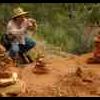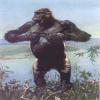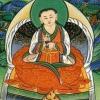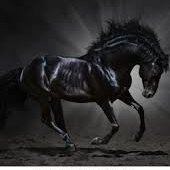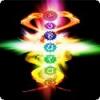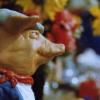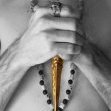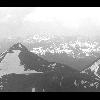Search the Community
Showing results for 'Dream'.
Found 7,591 results
-
I do realize that rigpa is not an entity at all, but rather the true nature of the individual. Whatever this was, it lacked emotion of any kind, and yet it was a Truth. I knew instinctively that this voice was right, that my depression was of my own choice, that I had my own egoic reasons for being in the depression and staying there (although Western medicine tells me that I am clinically depressed and require medication); but i do realize how sub-standard and unrefined Western medicine is compared to the wisdom and experience of the Eastern traditions. The book I am reading, 'The Tibetan Yogas of Dream and Sleep', by the aforementioned Rinpoche, defines rigpa fully as: 'Literally, "awareness" or "knowing". In the Dzoghen teachings, rigpa means awareness of the truth, innate awareness, the true nature of the individual.' It is from this perspective, the above definition, that the connect-up occurred in my mind, to that which happened some years ago. My memory sprang immediately to that experience of hearing the voice of Knowing, and knowing that it was the voice of truth. The thing that sticks with me the most is the lack of emotion contained in that part of me that clearly spoke to me. As I said previously, it just felt like a Dweller; a wisdom within that was separate from my tremendously emotional self at that moment. It Knew. This is why the phenomenon seemed to match up with the definition. I do understand that it is not literally an entity within. That it is nowhere, as All is Awareness and interconnectedness, that all our Awareness combined is the same Awareness. However, my Awareness was so clouded by the egoic wallowing of self-pity, I had strayed so far from my 'true nature', the contrast was so great - that I was given the opportunity (or rather, heard the opportunity) to see the difference between the two. Between what was real and what was unreal. If my understanding of rigpa is incorrect, please set me straight. And if my understanding is wrong, then how strange that my memory so readily recognized and snapped to an occurrence years back, instantaneously recognizing it as I read it.
-
What a wonderful topic. I look at it this way. Eternity has no beginning, it has no end. We are here, we will always be here, we have always been here. People tend to think of eternity as 'the future', but it's also 'the past'. I think when somebody has a near-death experience or a personal experience where the One is reached, this seems to take the fear out of the equation. Personally, one night when my husband and I were having a sexual encounter, we both ended up in Tantra-land. That changed everything. The place was a golden, warm, humming envelope of beingness - I had a definite immediate knowledge that this was the collective of souls. My intuition tells me this is the collective place where souls rest, and where my soul will go return. It is a wonderful place where time does not pass. It is all Now. If this is what death is, I'll be happy to return there. Whether this is true or not is irrelevant to me; it took many fears away, and it gave me something to look forward to. I go along with the lucid dream idea too. I'll bet that a Christian may envision Jesus upon death, a Buddhist may envision the Buddha. I think death will be whatever our life has conditioned it to be, as to what our lucid dream will show.
-
Well lol technically no...I just became a bit confused as to what it was you were saying. Although to be fair I could have tried a little harder to understand, instead of being lazy and just asking! Well all that presumes, for example that is physical reality is the only one that exists/matters. Yes certain things are true, in a relative way however. Generally speaking you are talking about absolute truth/absolute reality, which I don't think exists per se. I think it's more along the lines of, you manifest your own reality. Interesting you use these examples because in the first car example, I genuinely believe if your focus is powerful enough/you've many decades of meditative experience or spiritual training you can literally manifest things (instantly) in your reality. Shoot, you even manifest your reality in more subtle ways, all the time! From my personal experience, the dream state and reality are not that different from each other. My take is this: The dream state is a sort of a trainer version of physical reality, in that it is very easy to manifest and create various things. Reality (waking/physical awareness), however requires more muscle (IE greater concentration, focus) in order to change things.
-
This guy you know is YOU as well. MARBlEHEAD= THE BUDDHA WITHIN, the awakened one. And his principles are deep, full of wisdom yet so obvious...the paticcasamuppada (interconnectedness of all phenomena) is basically telling us that everything contained within Samsara, the Dream, Maya, etc... (whatever term you fancy) is connected like a giant web of cause and effect, you are attached to that web via mini-electrical impulses, like wires to a giant electric circuit. When you realise about the connection then you will notice the nature of karma and suffering. Spiritual liberation is a result of jumping off the circuit within the circuit itself, you will reach the state of Nirvana. Peace at last. Now that state is impossible to describe, but what I felt is that you'll dissolve yourself into nothingness and then...no idea what happens next...man it is extremely difficult to reach that last, ultimate jump. I wish it was easier! I wish that too, but unfortunately within the giant dream it's not possible...because of one simple little thing (not that simple, not that little) called IMPERMANENCE. Even the happy and powerful devas suffer somehow because they are bound by it, especially when they lose their companions due to karma. May all sentient beings end their suffering and endless round of rebirths.
-
To notice and remember coincidence is to hone awareness. Whether random or the universes subtle message system, its a good skill to develop. I collect old 'wheaty' pennies. I've found 2 of them the last 2 months, a 1936 and a 1946. They're increasingly rare enough so that people go years without finding one. My secret.. I like them, I look.. I've collected a few hundred of them in change. I find coins on the street all the time. Today it was some strange oriental coin. I'll ponder what message the find might represent, with dimes being bad luck. I don't always follow it, but I like the philosophy to treat waking life more as a dream, and take dreams as serious messages.
-
From my experience as a beginner, good visualisation is very important. Of course I too had trouble visualising, but with practice you become somewhat better, not completely perfect though. Some times you'll visualise better than others, I suppose if done in retreat it is more easy to progress in visualising. Also if you have a conscious dream you can meditate and visualise in your dream very very clear. However I don't know how to purposely cause such dreams. It is important to keep trying even though it seems hopeless at first. I hope others more knowledgable will tell you more.
-
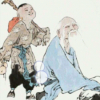
Interesting article on the I Ching and its translations into Western languages
Walker posted a topic in Daoist Discussion
http://www.chinafile.com/library/nyrb-china-archive/what-i-ching What Is the I Ching? Eliot Weinberger February 25, 2016 The I Ching has served for thousands of years as a philosophical taxonomy of the universe, a guide to an ethical life, a manual for rulers, and an oracle of one’s personal future and the future of the state. It was an organizing principle or authoritative proof for literary and arts criticism, cartography, medicine, and many of the sciences, and it generated endless Confucian, Taoist, Buddhist, and, later, even Christian commentaries, and competing schools of thought within those traditions. In China and in East Asia, it has been by far the most consulted of all books, in the belief that it can explain everything. In the West, it has been known for over three hundred years and, since the 1950s, is surely the most popularly recognized Chinese book. With its seeming infinitude of applications and interpretations, there has never been a book quite like it anywhere. It is the center of a vast whirlwind of writings and practices, but is itself a void, or perhaps a continually shifting cloud, for most of the crucial words of the I Ching have no fixed meaning. The origin of the text is, as might be expected, obscure. In the mythological version, the culture hero Fu Xi, a dragon or a snake with a human face, studied the patterns of nature in the sky and on the earth: the markings on birds, rocks, and animals, the movement of clouds, the arrangement of the stars. He discovered that everything could be reduced to eight trigrams, each composed of three stacked solid or broken lines, reflecting the yin and yang, the duality that drives the universe. The trigrams themselves represented, respectively, heaven, a lake, fire, thunder, wind, water, a mountain, and earth (see illustration below). From these building blocks of the cosmos, Fu Xi devolved all aspects of civilization—kingship, marriage, writing, navigation, agriculture—all of which he taught to his human descendants. Here mythology turns into legend. Around the year 1050 BCE, according to the tradition, Emperor Wen, founder of the Zhou dynasty, doubled the trigrams to hexagrams (six-lined figures), numbered and arranged all of the possible combinations—there are 64—and gave them names. He wrote brief oracles for each that have since been known as the “Judgments.” His son, the Duke of Zhou, a poet, added gnomic interpretations for the individual lines of each hexagram, known simply as the “Lines.” It was said that, five hundred years later, Confucius himself wrote ethical commentaries explicating each hexagram, which are called the “Ten Wings” (“wing,” that is, in the architectural sense). The archaeological and historical version of this narrative is far murkier. In the Shang dynasty (which began circa 1600 BCE) or possibly even earlier, fortune-telling diviners would apply heat to tortoise shells or the scapulae of oxen and interpret the cracks that were produced. Many of these “oracle bones”—hundreds of thousands of them have been unearthed—have complete hexagrams or the numbers assigned to hexagrams incised on them. Where the hexagrams came from, or how they were interpreted, is completely unknown. Sometime in the Zhou dynasty—the current guess is around 800 BCE—the 64 hexagrams were named, and a written text was established, based on the oral traditions. The book became known as the Zhou Yi (Zhou Changes). The process of consultation also evolved from the tortoise shells, which required an expert to perform and interpret, to the system of coins or yarrow stalks that anyone could practice and that has been in use ever since. Three coins, with numbers assigned to heads or tails, were simultaneously tossed; the resulting sum indicated a solid or broken line; six coin tosses thus produced a hexagram. In the case of the yarrow stalks, 50 were counted out in a more laborious procedure to produce the number for each line. (Wikimedia Commons) A diagram of ‘I Ching’ hexagrams sent to Gottfried Wilhelm Leibniz from Joachim Bouvet. The Arabic numerals were added by Leibniz. By the third century BCE, with the rise of Confucianism, the “Ten Wings” commentaries had been added, transforming the Zhou Yi from a strictly divinatory manual to a philosophical and ethical text. In 136 BCE, Emperor Wu of the Han dynasty declared it the most important of the five canonical Confucian books and standardized the text from among various competing versions (some with the hexagrams in a different order). This became the I Ching, the Book (or Classic) of Change, and its format has remained the same since: a named and numbered hexagram, an arcane “Judgment” for that hexagram, an often poetic interpretation of the image obtained by the combination of the two trigrams, and enigmatic statements on the meaning of each line of the hexagram. Confucius almost certainly had nothing to do with the making of the I Ching, but he did supposedly say that if he had another hundred years to live, 50 of them would be devoted to studying it. For two millennia, the I Ching was the essential guide to the universe. In a philosophical cosmos where everything is connected and everything is in a state of restless change, the book was not a description of the universe but rather its most perfect microcosm. It represented, as one Sinologist has put it, the “underpinnings of reality.” Its 64 hexagrams became the irrevocable categories for countless disciplines. Its mysterious “Judgments” were taken as kernels of thought to be elaborated, in the “Ten Wings” and countless commentaries, into advice to rulers on how to run an orderly state and to ordinary people on how to live a proper life. It was a tool for meditation on the cosmos and, as a seamless piece of the way of the world, it also revealed what would be auspicious or inauspicious for the future. In the West, the I Ching was discovered in the late 17th century by Jesuit missionaries in China, who decoded the text to reveal its Christian universal truth: hexagram number one was God; two was the second Adam, Jesus; three was the Trinity; eight was the members of Noah’s family; and so on. Leibniz enthusiastically found the universality of his binary system in the solid and broken lines. Hegel—who thought Confucius was not worth translating—considered the book “superficial”: “There is not to be found in one single instance a sensuous conception of universal natural or spiritual powers.” The first English translation was done by Canon Thomas McClatchie, an Anglican cleric in Hong Kong. McClatchie was a Reverend Casaubon figure who, in 1876, four years after the publication of Middlemarch, found the key to all mythologies and asserted that the I Ching had been brought to China by one of Noah’s sons and was a pornographic celebration of a “hermaphroditic monad,” elsewhere worshiped among the Chaldeans as Baal and among Hindus as Shiva. James Legge, also a missionary in Hong Kong and, despite a general loathing of China, the first important English-language translator of the Chinese classics, considered McClatchie “delirious.” After 20 interrupted years of work—the manuscript was lost in a shipwreck in the Red Sea—Legge produced the first somewhat reliable English translation of the I Ching in 1882, and the one that first applied the English word for a six-pointed star, “hexagram,” to the Chinese block of lines. Professionally appalled by what he considered its idolatry and superstition, Legge nevertheless found himself “gradually brought under a powerful fascination,” and it led him to devise a novel theory of translation. Since Chinese characters were not, he claimed, “representations of words, but symbols of ideas,” therefore “the combination of them in composition is not a representation of what the writer would say, but of what he thinks.” The translator, then, must become “en rapport” with the author, and enter into a “seeing of mind to mind,” a “participation” in the thoughts of the author that goes beyond what the author merely said. Although the I Ching has no author, Legge’s version is flooded with explanations and clarifications parenthetically inserted into an otherwise literal translation of the text. Herbert Giles, the next important English-language translator after Legge, thought the I Ching was “apparent gibberish”: “This is freely admitted by all learned Chinese, who nevertheless hold tenaciously to the belief that important lessons could be derived from its pages if only we had the wit to understand them.” Arthur Waley, in a 1933 study—he never translated the entire book—described it as a collection of “peasant interpretation” omens to which specific divinations had been added at a later date. Thus, taking a familiar Western example, he wrote that the omen “red sky in the morning, shepherds take warning” would become the divination “red sky in the morning: inauspicious; do not cross the river.” Waley proposed three categories of omens—“inexplicable sensations and involuntary movements (‘feelings,’ twitchings, stumbling, belching and the like)…those concerning plants, animals and birds…[and] those concerning natural phenomena (thunder, stars, rain etc.)”—and found examples of all of them in his decidedly unmetaphysical reading of the book. Joseph Needham devoted many exasperated pages to the I Ching in Science and Civilization in China as a “pseudo-science” that had, for centuries, a deleterious effect on actual Chinese science, which attempted to fit exact observations of the natural and physical worlds into the “cosmic filing-system” of the vague categories of the hexagrams. It was Richard Wilhelm’s 1924 German translation of the I Ching and especially the English translation of the German by the Jungian Cary F. Baynes in 1950 that transformed the text from Sinological arcana to international celebrity. Wilhelm, like Legge, was a missionary in China, but unlike Legge was an ardent believer in the Wisdom of the East, with China the wisest of all. The “relentless mechanization and rationalization of life in the West” needed the “Eastern adhesion to a natural profundity of soul.” His mission was to “join hands in mutual completion,” to uncover the “common foundations of humankind” in order to “find a core in the innermost depth of the humane, from where we can tackle…the shaping of life.” Wilhelm’s translation relied heavily on late, Song Dynasty Neo-Confucian interpretations of the text. In the name of universality, specifically Chinese referents were given general terms, and the German edition had scores of footnotes noting “parallels” to Goethe, Kant, the German Romantics, and the Bible. (These were dropped for the English-language edition.) The text was oddly presented twice: the first time with short commentaries, the second time with more extended ones. The commentaries were undifferentiated amalgams of various Chinese works and Wilhelm’s own meditations. (Needham thought that the edition belonged to the “Department of Utter Confusion”: “Wilhelm seems to be the only person…who knew what it was all about.”) The book carried an introduction by Carl Jung, whom Wilhelm considered “in touch with the findings of the East [and] in accordance with the views of the oldest Chinese wisdom.” (One proof was Jung’s male and female principles, the anima and the animus, which Wilhelm connected to yin and yang.) Some of Jung’s assertions are now embarrassing. (“It is a curious fact that such a gifted and intelligent people as the Chinese have never developed what we call science.”) But his emphasis on chance—or synchronicity, the Jungian, metaphysical version of chance—as the guiding principle for a sacred book was, at the time, something unexpected, even if, for true believers, the I Ching does not operate on chance at all. The Wilhelm/Baynes Bollingen edition was a sensation in the 1950s and 1960s. Octavio Paz, Allen Ginsberg, Jorge Luis Borges, and Charles Olson, among many others, wrote poems inspired by its poetic language. Fritjof Capra in The Tao of Physics used it to explain quantum mechanics and Terence McKenna found that its geometrical patterns mirrored the “chemical waves” produced by hallucinogens. Others considered its binary system of lines a prototype for the computer. Philip K. Dick and Raymond Queneau based novels on it; Jackson Mac Low and John Cage invented elaborate procedures using it to generate poems and musical compositions. It is not difficult to recuperate how thrilling the arrival of the I Ching was both to the avant-gardists, who were emphasizing process over product in art, and to the anti-authoritarian counterculturalists. It brought, not from the soulless West, but from the mysterious East, what Wilhelm called “the seasoned wisdom of thousands of years.” It was an ancient book without an author, a cyclical configuration with no beginning or end, a religious text with neither exotic gods nor priests to whom one must submit, a do-it-yourself divination that required no professional diviner. It was a self-help book for those who wouldn’t be caught reading self-help books, and moreover one that provided an alluring glimpse of one’s personal future. It was, said Bob Dylan, “the only thing that is amazingly true.” The two latest translations of the I Ching couldn’t be more unalike; they are a complementary yin and yang of approaches. John Minford is a scholar best known for his work on the magnificent five-volume translation of The Story of the Stone (or The Dream of the Red Chamber), universally considered the greatest Chinese novel, in a project begun by the late David Hawkes. His I Ching, obviously the result of many years of study, is over 800 pages long, much of it in small type, and encyclopedic. Minford presents two complete translations: the “Bronze Age Oracle,” a recreation of the Zhou dynasty text before any of the later Confucian commentaries were added to it, and the “Book of Wisdom,” the text as it was elucidated in the subsequent centuries. Each portion of the entries for each hexagram is accompanied by an exegesis that is a digest of the historical commentaries and the interpretations by previous translators, as well as reflections by Minford himself that link the hexagram to Chinese poetry, art, ritual, history, philosophy, and mythology. It is a tour de force of erudition, almost a microcosm of Chinese civilization, much as the I Ching itself was traditionally seen. David Hinton is, with Arthur Waley and Burton Watson, the rare example of a literary Sinologist—that is, a classical scholar thoroughly conversant with, and connected to, contemporary literature in English. A generation younger than Watson, he and Watson are surely the most important American translators of Chinese classical poetry and philosophy in the last 50 years. Both are immensely prolific, and both have introduced entirely new ways of translating Chinese poetry. Hinton’s I Ching is equally inventive. It is quite short, with only two pages allotted to each hexagram, presents a few excerpts from the original “Ten Wings” commentaries, but has nothing further from Hinton himself, other than a short introduction. Rather than consulted, it is meant to be read cover to cover, like a book of modern poetry—though it should be quickly said that this is very much a translation, and not an “imitation” or a postmodern elaboration. Or perhaps its fragments and aphorisms are meant to be dipped into at random, the way one reads E.M. Cioran or Elias Canetti. Hinton adheres to a Taoist or Ch’an (Zen) Buddhist reading of the book, unconcerned with the Confucian ethical and political interpretations. His I Ching puts the reader into the Tao of nature: that is, the way of the world as it is exemplified by nature and embodied by the book. He takes the mysterious lines of the judgments as precursors to the later Taoist and Ch’an writings: “strategies…to tease the mind outside workaday assumptions and linguistic structures, outside the limitations of identity.” The opposite of Wilhelm’s Jungian self-realization, it is intended as a realization of selflessness. Moreover, it is based on the belief that archaic Chinese culture, living closer to the land—and a land that still had a great deal of wilderness—was less estranged from nature’s Tao. To that end, Hinton occasionally translates according to a pictographic reading of the oldest characters, a technique first used by Ezra Pound in his idiosyncratic and wonderful version of the earliest Chinese poetry anthology, the Book of Songs, which he titled The Confucian Odes. For example, Hinton calls Hexagram 32—usually translated as “Endurance” or “Duration” or “Perseverance”—“Moondrift Constancy,” because the character portrays a half-moon fixed in place with a line above and below it. The character for “Observation” becomes “Heron’s-Eye Gaze,” for indeed it has a heron and an eye in it, and nothing watches more closely than a waterbird. Hinton doesn’t do this kind of pictographic reading often, but no doubt Sinologists will be scandalized. The difference between the two translations—the differences among all translations—is apparent if we look at a single hexagram: number 52, called Gen. Minford translates the name as “Mountain” for the hexagram is composed of the two Mountain trigrams, one on top of the other. His translation of the text throughout the book is minimalist, almost telegraphese, with each line centered, rather than flush left. He has also made the exceedingly strange decision to incorporate tags in Latin, taken from the early Jesuit translations, which he claims can help us relate to this deeply ancient and foreign text, can help create a timeless mood of contemplation, and at the same time can evoke indirect connections between the Chinese traditions of Self-Knowledge and Self-Cultivation…and…the long European tradition of Gnosis and spiritual discipline. In the “Book of Wisdom” section, he translates the “Judgment” for Hexagram 52 as: The back Is still As a Mountain; There is no body. He walks In the courtyard, Unseen. No Harm, Nullum malum. This is followed by a long and interesting exegesis on the spiritual role and poetic image of mountains in the Chinese tradition. Hinton calls the hexagram “Stillness” and translates into prose: “Stillness in your back. Expect nothing from your life. Wander the courtyard where you see no one. How could you ever go astray?” Wilhelm has “Keeping Still, Mountain” as the name of the hexagram. His “Judgment” reads: KEEPING STILL. Keeping his back still So that he no longer feels his body. He goes into the courtyard And does not see his people. No blame. He explains: True quiet means keeping still when the time has come to keep still, and going forward when the time has come to go forward. In this way rest and movement are in agreement with the demands of the time, and thus there is light in life. The hexagram signifies the end and beginning of all movement. The back is named because in the back are located all the nerve fibers that mediate movement. If the movement of these spinal nerves is brought to a standstill, the ego, with its restlessness, disappears as it were. When a man has thus become calm, he may turn to the outside world. He no longer sees in it the struggle and tumult of individual beings, and therefore he has that true peace of mind which is needed for understanding the great laws of the universe and for acting in harmony with them. Whoever acts from these deep levels makes no mistakes. The Columbia University Press I Ching, translated by Richard John Lynn and billed as the “definitive version” “after decades of inaccurate translations,” has “Restraint” for Gen: “Restraint takes place with the back, so one does not obtain [sic] the other person. He goes into that one’s courtyard but does not see him there. There is no blame.” Lynn’s odd explanation, based on the Han dynasty commentator Wang Bi, is that if two people have their backs turned, “even though they are close, they do not see each other.” Therefore neither restrains the other and each exercises self-restraint. The six judgments for the six individual lines of Hexagram 52 travel through the body, including the feet, calves, waist, trunk, and jaws. (Wilhelm weirdly and ahistorically speculates that “possibly the words of the text embody directions for the practice of yoga.”) Thus, for line 2, Hinton has: “Stillness fills your calves. Raise up succession, all that will follow you, or you’ll never know contentment.” Minford translates it as: “The calves are/Still as a Mountain./Others/Are not harnessed./The heart is heavy.” He explains: “There is a potential healing, a Stillness. But the Energy of Others…cannot be mastered and harnessed. No Retreat is possible, only a reluctant acceptance. One lacks the foresight for Retreat. Beware.” Wilhelm’s version is: “Keeping his calves still./He cannot rescue him whom he follows./His heart is not glad.” This is glossed as: The leg cannot move independently; it depends on the movement of the body. If a leg is suddenly stopped while the whole body is in vigorous motion, the continuing body movement will make one fall. The same is true of a man who serves a master stronger than himself. He is swept along, and even though he himself may halt on the path of wrongdoing, he can no longer check the other in his powerful movement. When the master presses forward, the servant, no matter how good his intentions, cannot save him. In the “Bronze Age Oracle” section—the original Zhou book without the later interpretations—Minford translates Gen as “Tending,” believing that it refers to traditional medicine and the need to tend the body. The “Judgment” for the entire hexagram reads: “The back/Is tended,/The body/Unprotected./He walks/In an empty courtyard./No Harm.” He suggests that the “empty courtyard” is a metaphor for the whole body, left untended. His judgement for the second line is: “The calves/Are tended./There is/No strength/In the flesh./The heart/Is sad,” which he glosses as “There is not enough flesh on the calves. Loss of weight is a concern, and it directly affects the emotions.” Both Richard J. Smith, in a monograph on the I Ching for the Princeton Lives of Great Religious Books series, and Arthur Waley take the hexagram back to the prevalent practice in the Shang dynasty of human and animal sacrifice. Smith translates Gen as “cleave” (but, in an entirely different reading, says that the word might also mean “to glare at”). His “Judgment” is puzzling: “If one cleaves the back he will not get hold of the body; if one goes into the courtyard he will not see the person. There will be no misfortune.” But his reading of line two is graphic: “Cleave the lower legs, but don’t remove the bone marrow. His heart is not pleased.” Waley thinks Gen means “gnawing,” and “evidently deals with omen-taking according to the way in which rats, mice or the like have deals with the body of the sacrificial victim when exposed as ‘bait’ to the ancestral spirit.” His “Judgment” is: “If they have gnawed its back, but not possessed themselves of the body,/It means that you will go to a man’s house, but not find him at home.” He reads line two as: “If they gnaw the calf of the leg, but don’t pull out the bone marrow, their (i.e. the ancestors’) hearts do not rejoice.” What is certain is that Hexagram 52 is composed of two Mountain trigrams and has something to do with the back and something to do with a courtyard that is either empty or where the people in it are not seen. Otherwise, these few lines may be about stillness, having no expectations, self-restraint, peace of mind, knowing when not to follow a leader, the care of various aches and pains, glaring at things, and the preparations for, and results of, human or animal sacrifices. None of these are necessarily misinterpretations or mistranslations. One could say that the I Ching is a mirror of one’s own concerns or expectations. But it’s like one of the bronze mirrors from the Shang dynasty, now covered in a dark blue-green patina so that it doesn’t reflect at all. Minford recalls that in his last conversation with David Hawkes, the dying master-scholar told him: “Be sure to let your readers know that every sentence can be read in an almost infinite number of ways! That is the secret of the book. No one will ever know what it really means!” In the I Ching, the same word means both “war prisoner” and “sincerity.” There is no book that has gone through as many changes as the Book of Change. -
Yeah. I like the Big Bang theory. But always try to remember that it is a theory. There is enough data to make the assumption but we need remember that it is only an assumption. Theories and assumptions are pretty ease to come up with. Facts are a bit more difficult. But given that this is not a dream and we really are manifestations of Dao we should live and question. We won't always get the answers we want or even get an answer at all.
-

So how does reincarnation work in Taoist theory?
Rara replied to Oneironaut's topic in Daoist Discussion
Hi Oneironaut, Correct, many different Taoist beliefs out there and I had the same debates a few years ago. Eventually I had to submit to myself and recognise that my curiosity and dabbling in all this was really out of my depth and quite frankly, is out of anyones. I went back to Tao Te Ching and realised I saw little correlation between so-called Taoist beliefs/practices and this initial foundation for the philosophy. That was my choice, and I guess that makes me the Taoist I "want to be"...or simply, the person "I am". One thing that is universal is that eventually, everything is subjective. The Taoist that believes in reincarnation is attracted to the idea. The Christian that believes in God is hopeful of said God and the afterlife. The atheist cannot fathom a world governed by a higher being, and does not care for it. So the answer is in yourself...regardless of what text says what. And if I'm to inflict my bias on you, I'd say, go away and be reincarnated then come back and tell us. Then see who believes you =P I wouldn't say the yin and yang is a theory at all, nor dismissed by science. It is an observation of polarity, the scale from hot to cold, from day to night, from peace to conflict etc. So simple yet so confused by those that want a debate. No this is just nature, watched by scientists today. Taoists in their own right. As for Neidan arts etc, I don't know. The more I go to "practice" meditation or kung fu forms etc, the more forced it seems. I get more benefit these days taking my fiancee's mum's dog for a walk. And I think Wu Ming Jen was trying to say that the idea of reincarnation is still an equivalent of leaving control with the man in the sky. Again, it's just another spiritual belief which has had no proving ground whatsoever. For me, the Taoist can watch the sun-rise and set...there's little more a human is capable of. Within this there is potential...check out Lao Tzu's "Limitless" comments. Then there's Chuang Tzu's butterfly dream. So yes, things can get a little imaginitive, but don't confuse imagination with what we can actually prove in our own waking reality. -
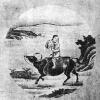
Reverse Breathing and Central Channel
Lucky7Strikes replied to Lucky7Strikes's topic in General Discussion
I can't sleep. Don't feel the need to eat. Everything is shrouded in clarity in perpetual motion. I don't feel time. I don't feel distance. Everything feels like a hallucinating dream. It feels like my waking state and dream state is merging. -
If you want to gain personal experience with the fact that consciousness can exist separately from the physcial body take up OBE. My understanding from Robert Bruce, people fall into an extremely realistic lucid dream after death. It is so realistic that people do not know they died. You could actually be dead right now LOL. And this you can also prove to yourself as well. It is called a WILD...Wake induced lucid dream. A WILD is as realistic as reality.
-
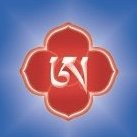
Individual will, reality creation and miracles
ilumairen replied to Nikolai1's topic in General Discussion
And yet, thinking it is our place to determine the time and place of another's awakening is a bit of a dream itself, imo. In that regard we are just further reflections in 'the hall of mirrors'. -
it is from a band in brazil idk their name. the songs title is Balada de robert johnson. yes it sounds very early creole . i would have offered a song or 2 from my home state if i had it may have been dream, dream and cathy's clown from the everly brothers. but i thought would might appreciate the Balada de robert johnson more
-
Project through your third eye a vision screen on the back of your hand, on the sky, on a blank wall, or on a pool of water. It's like opening a window to the dream world/ spirit world. That's the basic concept. I learned it from a fellow traveler so i think you should try to download the technology from the dream world. use your imagination. its the key to the third eye.
-
I had the same dream with my mum when I was a kid ,it was very complex but exactly the same.I tend to think it has to do with people being very close or concentrating on each other for one reason or another quite intenlesy.And the other instance with voice could be just a premonition type of dream which happens to most people at some point/s in their life.And even more chance for people who cultivate and are in tune.
-

Colors blind the eye / Sounds deafen the ear
manitou replied to manitou's topic in Daoist Discussion
Hi mostly_empty - However, when you get back to the reversion of the Dao to the void, does it not come down to the same thing? That one could call it samsara because it reverts back to none other than thought? Our thought? I'm not seeing a huge distinction there. I woke up out of a dream last night, and wrote down what a voice was telling me. This could relate to what the misfortune is that we're speaking of. The voice said "Be one with the pain, realizing that it's not hurting us at all, but merely this shell that we must walk around in." -

Working with higher level subtle beings and spirits
ChiForce replied to Jetsun's topic in General Discussion
To Harmonious Emptiness.....Hahahaha...so true.... It brings back dream memories here..hehehe..... -

Working with higher level subtle beings and spirits
ChiForce replied to Jetsun's topic in General Discussion
May I....?? Been away for a while and haven't been posting..... The question is what does you mind want??? Look, my path was transmitted to me in dreams. Higher, spirit, realized Buddha beings (Sambhogakaya beings to be précised) taught me about the Dharma gate, the Kundalini energy rising, and the microcosmic orbit. I know things and wisdom which would have required extensive studies of the Buddha scriptures to realize. Yet, I can grasp them using my own experiences and insights. I believe the higher your cultivation level you are at, the more you would need to rely on these beings to guide you...maybe because your path is unique and no known masters can guide you...or you are the self enlightened Buddha. The thing about these beings is that they are the reflection of your mind and the quality of your cultivation. I personally do not believe that higher individual beings would manifest themselves to you when your cultivation level, your mind realization, is of lesser realization. The point of the mind nature realization is that all phenomena is the product of your own mind. If so, how can anything exist outside of your mind. How can real higher beings can be perceived by your mind if your mind isn't capable of seeing them the way they are? Of course, regardless what messages they are telling you, you must realize that your mind may not have altered or changed your own surrounding reality. If some beings are teaching you about energy healing and you can't heal anything in your real life, well, you really can not heal, period.... Is simple as that. If your mind cultivation is strong and really grasps the Dharma wisdom, as soon as these beings appear, you mind would wonder and not grasping. Whatever thoughts and visions before you.... would transform into the Clear Light. Your visions or dream visions would switch from imagery representations to a full blown Clear Light realization...your third eye would see only light and nothing more...the nature of your mind itself. Also, once the mind developed the ability to distinguish the reality of these beings, you don't get low level being visitations as much. -
So last night I had a dream about people living in a place full of poop and vomit (which is how I sometimes categorize too many words, word vomit - heck too many words can also be diarrhea of the mouth to me). They thought it was good and normal, and the longer I stayed the more I wretched out. It was not what I would call pleasant experience, but it was still experience - which I prefer not to confuse with who I am. (just a happy song)
-
My solution to the problem was to use a digital voice recorder. That way, I could quickly get whatever it is down, without having to think too much about structure, presentation or handwriting. Downside, of course, is that I never get back to those old journals, but then, I never get back to my earlier written journals, either. You could record the dream immediately, and then listen back to it, say, while driving to work. That way, the dream has been 1. recorded, and 2. listened to, so it's already more in your system (and if you really want to be able to find an entry again, you can probably star it, on your computer).
-
http://www.youtube.com/watch?v=YUdG4RiO268 A cloud of eiderdown draws around me Softening the sound Sleepy time when I lie with my love by my side And she's breathing low, and the candle dies When night comes down you lock the door The book falls to the floor As darkness falls and waves roll by The seasons change, the wind is warm Now wakes the owl, now sleeps the swan Behold a dream, the dream is gone Green fields, a cold rain is falling in a golden dawn And deep beneath the ground the early morning sounds And I go down Sleepy time when I lie with my love by my side And she's breathing low And I rise like a bird, In the haze when the first rays touch the sky And the night winds die.
-
Stopping all practices is the advice that is generally given. You can't balance it out by doing increased grounding to continued practice-from my experience. Living in a subjective dream world loosens the grip on reality, the more that you break the link between reality and cognitive function, the greater becomes the disorientation. It's not too dissimilar to alcoholism, or other mental addictions. Eventually you either quit, or go on to ruin. Rarely does it get that self destructive, but it isn't impossible. Best to play at the edge of the pool than go so far out that you drown. Keep one limb on the bank by continually grounding. That way you don't overdose. Go too far out and the water gets deep- really, really deep.
-
So ... there is no plan ... it's just a romantic dream.
-
I lucid dream about once every 2 or 3 months. I enter the lucid state becuas I'm constantly questiong whats going on and my reality when I'm awake. Usually my minds finally stops thinking when I sleep but not always. When it doesn't I lucid dream.
-
It's a lucid dream that I'm aware of as I am awakening. I can prolong the state by not opening my eyes or trying to think too much. I am aware of each word and recognize it as being a viable English word, but my mind can't put the words together in a recognizable sentence. They're disjointed. But I'm definitely 'awake', as you would be in a lucid dream. then when I open my eyes, I'm awake.



